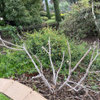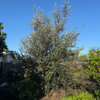I purchased a s. clevelandii in a gallon container early last summer. I repotted it in a 14" pot, made sure it didn't get too much water and nothing happened. I mean nothing. It looks exactly the same as it did when I got it except for the few missing seed heads. It's not dead, but it's not growing.
What's the correct way to grow them in pots? I love the scent of this sage. Even this little domant plant has good scent.
Do they like to be root bound? Should I use cactus mix and/or more pumice or sand? More water? I've assumed it doesn't need to be fertilized yet, but maybe in a container, it needs a little more help? Thanks, Kristine










calistoga_al ca 15 usda 9
youreit
Related Professionals
Manorville Landscape Architects & Landscape Designers · Davidson Landscape Contractors · Hilo Landscape Contractors · Lemont Landscape Contractors · Mashpee Landscape Contractors · Oklahoma City Landscape Contractors · Pahrump Landscape Contractors · Secaucus Landscape Contractors · South Farmingdale Landscape Contractors · Charlottesville Swimming Pool Builders · Tampa Swimming Pool Builders · Fort Washington Window Contractors · Kearns Window Contractors · Scotts Valley Window Contractors · Waupun Window Contractorskelpmermaid
CA Kate z9
kristinecaOriginal Author
wanda
wanda
ruby138
dicot
wanda
calistoga_al ca 15 usda 9
hoovb zone 9 sunset 23
ruby138
peachiekean
pansysoup
calistoga_al ca 15 usda 9
pansysoup
calistoga_al ca 15 usda 9
tressa
arvind
earthmama3
ccroulet
ladyslppr
User
lisascenic Urban Gardener, Oakland CA
kelpmermaid
ladyslppr
aquilachrysaetos
ccroulet
CA Kate z9